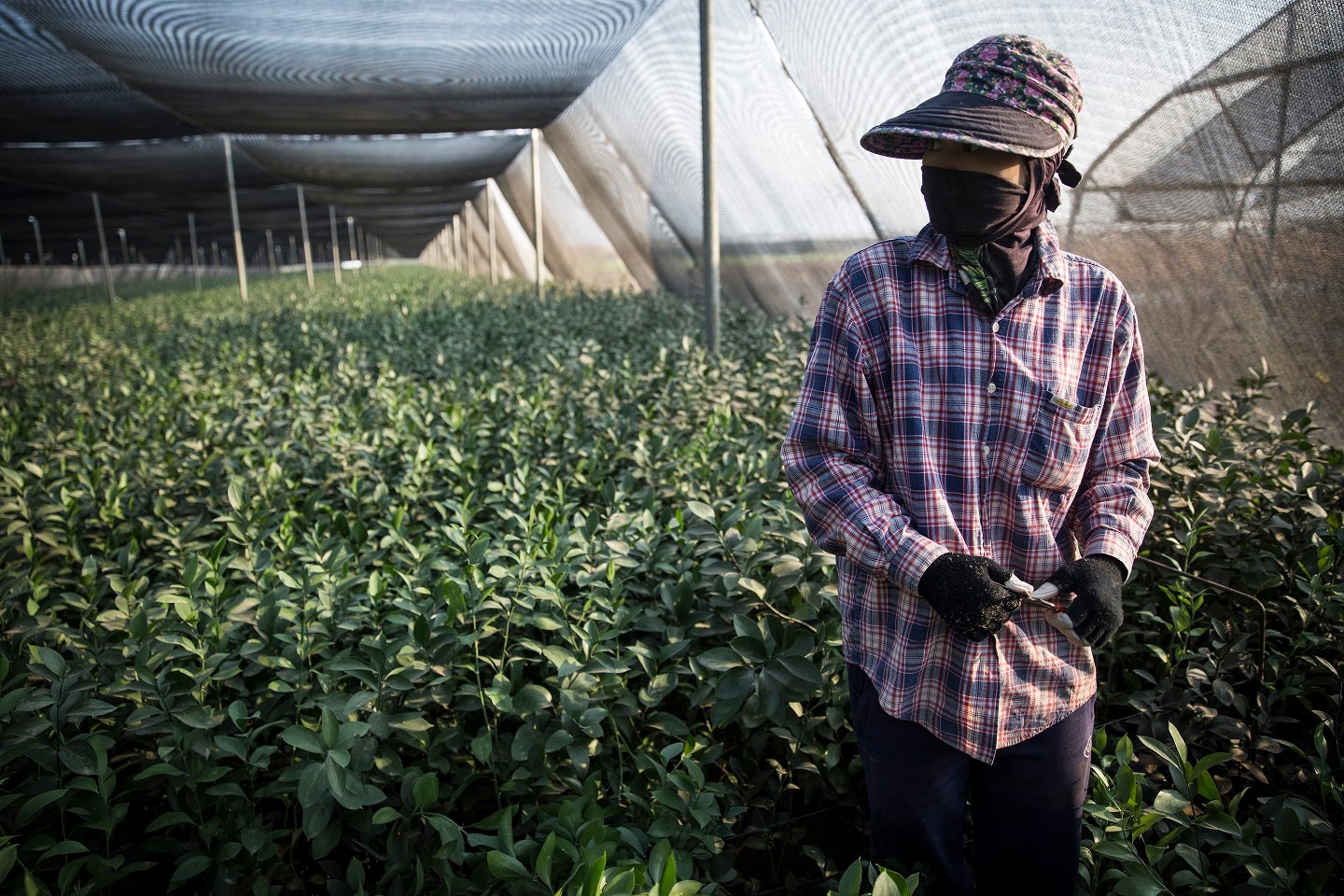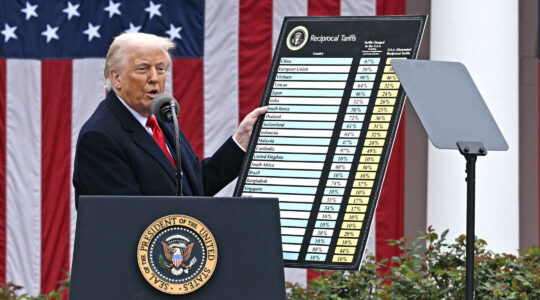TEL AVIV (JTA) — When Rosh Hashanah comes later this month, Israel’s Jewish farmers won’t just be celebrating the start of a new year. They’ll be marking a year in which they are prohibited from doing their jobs.
Called Shmita, the Torah-mandated, yearlong farming hiatus is felt across Israel, affecting its fields, supermarkets and, of course, its politics.
The genesis of Shmita is Exodus, which commands the Israelites, “Plant your land and gather its produce for six years. But on the seventh let it lie fallow and it will rest …” Other biblical mandates prohibit planting, trimming or harvesting crops during Shmita, amounting to a total prohibition on farming.
In advance of Shmita, which takes place every seventh year, here are seven things you should know about Israel’s sabbatical year.
What is Shmita?
According to the Torah mandates, the Shmita year is something like an agricultural Shabbat. Just like everyone is commanded to rest for a day at the end of every week, Shmita is a chance to let the land rest for a year after six years of work.
It’s easy to calculate when Shmita comes around: Start from year zero in the Jewish calendar — that would be 5,775 years ago — and count off every seven years; this is Israel’s 466th Shmita.
The concept of the sabbatical year has spread to academics and clergy, many of whom receive sabbaticals to travel and study. And the root of the word “shmita” has found contemporary usage in Hebrew. Israelis use the word “mishtamet” to refer to someone who dodged mandatory military conscription.
How was Shmita observed in the past?
Because the commandment applies only in the biblical land of Israel, it became largely theoretical once the Jews were exiled by the Roman Empire after the Bar Kochba revolt in 136 C.E. Generations of Jewish farmers in Europe, the Middle East and elsewhere had no religious imperative to let the land rest.
But once Jews started returning to Palestine in the 1880s and founding kibbutzim, Shmita again became relevant — and problematic. At a time when Jewish farmers were struggling just to keep their farms viable, a year of no production would have been a deathblow.
To skirt that problem, rabbis in Israel created something called the “heter mechirah,” or sale permit — similar to the sale of leavened food before Passover. The permit allowed Jewish farmers to “sell” their land to local non-Jews for a token amount, then hire non-Jews to do the forbidden labor. That way, because it wasn’t “their” land, Jews could keep their farms going without sin.
How is Shmita observed in contemporary Israel?
As Israel’s population and agricultural sector expanded, so too has the hand-wringing over Shmita. Here are some of the Jewish legal acrobatics they use to get around it.
The sale permit: Israel’s Chief Rabbinate allows every farm to register for a sale permit like those allowed in the 1880s, and the Rabbinate “sells” all the land to a non-Jew for about $5,000 total, according to Rabbi Haggai Bar Giora, who oversaw Shmita for Israel’s Chief Rabbinate seven years ago. At the end of the year, the Rabbinate buys back the land on the farmers’ behalf for a similar amount. Bar Giora chose a non-Jewish buyer who observes the seven Noahide laws — the Torah’s commandments for non-Jews.
Greenhouses: Shmita only applies if the crops are grown in the land itself. Therefore, growing vegetables on tables disconnected from the land steers clear of violating the commandment.
Religious courts: Farmers aren’t allowed to sell their crops, but if crops began growing before Shmita started, people are allowed to take them for free. So through another legal mechanism, a Jewish religious court will hire farmers to harvest the produce and the religious court will sell it. But you won’t be paying for the produce itself; you’re only paying for the farmer’s labor. You get the produce for “free.” Wink. Nudge.
Not observing Shmita: Most large-scale Israeli farmers use a sale permit in order to obtain rabbinic certification for their crops, Bar Giora says. But some small, nonreligious farmers who sell their produce independently ignore the sabbatical year completely and do not receive kosher certification.
What happens to fruits, vegetables and other plants that grow on their own during Shmita?
Just like Jewish environmentalists can connect to the idea of letting the land rest, social justice-minded Jews can appreciate that whatever grows on the land during Shmita is, in theory, supposed to be free for anyone, especially the poor.
When Shmita is first mentioned in Exodus, the Torah says the crops should be for “the poor of your nation, and the rest for wild animals.” But given that almost all farmers in Israel get around Shmita in one way or another, walking onto a farm looking for a free lunch is ill advised.
How does Shmita affect you if you’re not a farmer?
Because all kosher-certified produce cannot violate Shmita, Israelis shopping in major grocery stores and outdoor markets don’t have to worry about Shmita.
But religious Jews — and businesses — that don’t trust the legal loopholes just buy their produce from non-Jewish farmers in Israel. An organization called Otzar Haaretz, or Fruit of the Land, seeks to support Jewish farmers specifically and is organizing farmers who use religious courts and the greenhouse method to sell to supermarkets in Israel. Customers who wish to buy from Otzar Haaretz can pay a monthly fee to get a discount on its produce.
Shmita has an impact beyond the produce stands, too. Mickey Gitzin, founder of the religious pluralism organization Be Free Israel, says that while the “the idea that the land should rest” is a positive one, Shmita can have a negative effect on public parks. As public property, the parks cannot be sold to a non-Jew. And because they remain under Jewish ownership, some public community gardens don’t receive care during Shmita.
What does this mean for Jews outside of Israel?
Although they’re not obligated to observe Shmita, Jews outside of Israel have found ways of commemorating the year. At Hazon, a Jewish sustainability organization, the Shmita Project aims to engage in a study of the textual sources of Shmita and develop programs to mark the year without letting the land lie completely fallow.
Another group, the Shmitta Association, has purchased a grid of 4-square-foot plots of land in Israel that Jews abroad can purchase for $180 and then let lie idle, enabling them to observe Shmita without being an Israeli or a farmer.
What does this have to do with the Israeli-Palestinian conflict?
Because they don’t want to buy from Jewish farmers during Shmita, some haredi Orthodox Jews buy from Palestinian West Bank farms. But during the past couple of Shmita cycles, there has been backlash against buying Palestinian-grown produce.
Jerusalem Post columnist David Weinberg urged Israelis last week to avoid supporting Palestinian farms.
“Primary reliance on Arab produce is neither realistic nor acceptable for health, nationalistic and religious reasons,” he wrote.
During the Shmita year that began in 2007, Israel’s health and agriculture ministries said there was no elevated risk to eating produce grown in the West Bank.
JTA has documented Jewish history in real-time for over a century. Keep our journalism strong by joining us in supporting independent, award-winning reporting.






